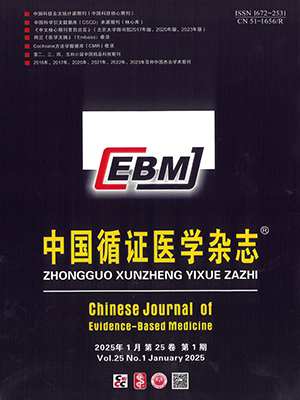| 1. |
GBD 2019 Stroke Collaborators. Global, regional, and national burden of stroke and its risk factors, 1990-2019: a systematic analysis for the global burden of disease study 2019. Lancet Neurol, 2021, 20(10): 795-820.
|
| 2. |
《中国脑卒中防治报告》编写组. 《中国脑卒中防治报告2020》概要. 中国脑血管病杂志, 2022, 19(2): 136-144.
|
| 3. |
张江, 常莉莎, 彭延波, 等. 急性脑梗死CISS分型评估1个月内预后的价值. 中国实用神经疾病杂志, 2017, 20(19): 48-51.
|
| 4. |
陈泽, 陈珏璇, 段玉婷, 等. 随机对照试验中的患者报告结局: CONSORTPRO扩展版. 中国循证医学杂志, 2021, 21(3): 347-354.
|
| 5. |
Kluetz PG, O'Connor DJ, Soltys K. Incorporating the patient experience into regulatory decision making in the USA, Europe, and Canada. Lancet Oncol, 2018, 19(5): e267-e274.
|
| 6. |
Fenton BW, Grey SF, Tossone K, et al. Classifying patients with chronic pelvic pain into levels of biopsychosocial dysfunction using latent class modeling of patient reported outcome measures. Pain Res Treat, 2015, 2015: 940675.
|
| 7. |
Pinheiro LC, Tan X, Olshan AF, et al. Examining health-related quality of life patterns in women with breast cancer. Qual Life Res, 2017, 26(7): 1733-1743.
|
| 8. |
Alonso-Recio L, Martín-Plasencia P, Ruiz M, et al. Differences in cognitive performance in nondemented Parkinson's disease: a latent profile analysis of cognitive subtypes. J Clin Exp Neuropsychol, 2018, 40(8): 777-789.
|
| 9. |
Saracino RM, Cham H, Rosenfeld B, et al. Latent profile analyses of depressive symptoms in younger and older oncology patients. Assessment, 2020, 27(7): 1383-1398.
|
| 10. |
Park J, Moser DK, Griffith K, et al. Exploring symptom clusters in people with heart failure. Clin Nurs Res, 2019, 28(2): 165-181.
|
| 11. |
Luo Y, Yang J, Zhang Y. Development and validation of a patient-reported outcome measure for stroke patients. Health Qual Life Outcomes, 2015, 13: 53.
|
| 12. |
Nelson EC, Eftimovska E, Lind C, et al. Patient reported outcome measures in practice. BMJ, 2015, 350: g7818.
|
| 13. |
Zhang F, Zhu T, Li H, et al. Plasma interleukin-37 is elevated in acute ischemic stroke patients and probably associated with 3-month functional prognosis. Clin Interv Aging, 2020, 15: 1285-1294.
|
| 14. |
Ungvari Z, Tarantini S, Sorond F, et al. Mechanisms of vascular aging, a geroscience perspective: JACC focus seminar. J Am Coll Cardiol, 2020, 75(8): 931-941.
|
| 15. |
谷强, 余孝君, 张津. 高龄与中低龄老年轻型缺血性脑卒中临床特点及预后分析. 首都医科大学学报, 2022, 43(3): 474-479.
|
| 16. |
Wang Y, Zhao X, Jiang Y, et al. Prevalence, knowledge, and treatment of transient ischemic attacks in China. Neurology, 2015, 84(23): 2354-2361.
|
| 17. |
曹英南, 关天嘉, 李晋磊, 等. 脑卒中患者住院费用及预后影响因素研究. 中国卫生政策研究, 2016, 9(5): 54-60.
|
| 18. |
崔牛牛, 张蕾. 农村高返贫风险脑卒中患者就诊行为与自评治疗效果关联分析. 中华疾病控制杂志, 2022, 26(4): 437-441, 496.
|
| 19. |
赵凯丽, 韦桂源, 农峰, 等. 慢性心力衰竭患者自我感受负担影响因素及干预措施的研究进展. 护理实践与研究, 2021, 18(20): 3033-3037.
|
| 20. |
郑瑞芳. 首次发病脑卒中患者自我管理现状及影响因素. 中国卫生工程学, 2019, 18(1): 44-46.
|
| 21. |
李萍, 孔海霞, 李洪娟. 有氧运动对脑卒中后慢性偏瘫患者下肢运动功能、血趋化素及代谢危险因素的影响. 中国动脉硬化杂志, 2017, 25(4): 393-397.
|
| 22. |
Nathoo C, Buren S, El-Haddad R, et al. Aerobic training in Canadian stroke rehabilitation programs. J Neurol Phys Ther, 2018, 42(4): 248-255.
|
| 23. |
Gezer H, Karaahmet OZ, Gurcay E, et al. The effect of aerobic exercise on stroke rehabilitation. Ir J Med Sci, 2019, 188(2): 469-473.
|
| 24. |
Linder SM, Rosenfeldt AB, Davidson S, et al. Forced, not voluntary, aerobic exercise enhances motor recovery in persons with chronic stroke. Neurorehabil Neural Repair, 2019, 33(8): 681-690.
|
| 25. |
Astuti P, Kusnanto K, Dwi Novitasari F. Depression and functional disability in stroke patients. J Public Health Res, 2020, 9(2): 1835.
|
| 26. |
Hepburn M, Bollu PC, French B, et a1. Sleep medicine: stroke and sleep. Mis Med, 2018, 115(6): 527-532.
|
| 27. |
Aguiar LT, Nadeau S, Britto RR, et al. Effects of aerobic training on physical activity in people with stroke: a randomized controlled trial. NeuroRehabilitation, 2020, 46(3): 391-401.
|




